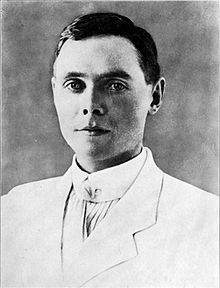From “Applied Eugenics” by Paul Popenoe, 1918 (MacMillan)
The United States birth-rate may, on its face, appear high enough; but its face does not show that this height is due largely to the fecundity of immigrant women. Statistics to prove this are given in Chapter XIII, but may be supplemented here by some figures from Pittsburgh.

5th St Pittsburgh, residence of one of Carnegie’s Lawyers (Now a nice bed and breakfast)
Ward 7, in that city, contains the homes of many well-to-do, and contains more representatives of the old American stock than any other ward in the city, having 56.4% of residents who are native born of native parents while the majority of the residents in nearly all the other wards in the city are either themselves foreign-born, or the offspring of foreign-born parents.
Ward 7 has the lowest birth-rate and the lowest rate of net increase of any ward in the city.

Ward 6 immigrant homes. Not as cozy.
With this may be contrasted the sixth ward, which runs along the south bank of the Allegheny river. It is one of the great factory districts of the city, but also contains a large number of homes. Nearly 3,000 of its 14,817 males of voting age are illiterate. Its death-rate is the highest in the city. Almost nine-tenths of its residents are either foreigners or the children of foreigners. Its birth-rate is three times that of the seventh ward.
Taking into account all the wards of the city, it is found that the birth-rate rises as one considers the wards that are marked by a large foreign population, illiteracy, poverty, and a high death-rate. On the other hand, the birth-rate falls as one passes to the wards that have most native-born residents, most education, most prosperity – and, to some extent, education and prosperity denote efficiency and eugenic value. For 27 wards tere is a high negative correlation (-.673) between birth-rate and percentage of native-born of native parents in the population. The correlation between illiteracy and net increase is +.731.
The net increase of Pittsburgh’s population, therefore, is greatest where the percentage of foreign-born and of illiterates is greater.
The significance of such figures in natural selection must be evident. Pittsburgh, like probably all large cities in civilized countries, breeds from the bottom. The lower a class is in the scale of intelligence, the greater is its reproductive contribution. Recalling that intelligence is inherited, that like begets like in this respect, one can hardly feel encouraged over the quality of the population of Pittsburgh, a few generations hence.
Of course these illiterate foreign laborers are, from a eugenic point of view, not wholly bad. The picture should not be painted any blacker than the original. Some of these ignorant stocks, in another generation and with decent surroundings, will furnish excellent citizens.
But taken as a whole, it can hardly be supposed that the fecund stocks of Pittsburgh, with their illiteracy, squalor and tuberculosis, their high death-rates, their economic straits, are as good eugenic material as the families that are dying out in the more substantial residence section which their fathers created in the eastern part of the city.
And it can hardly be supposed that the city, and the nation, of the future, would not benefit by a change in the distribution of births, whereby more would come from the seventh ward and its like and fewer from the sixth and its like.
Evidently, there is no difficulty about sitting this form of natural selection at work, and at work in such a way as greatly to change the character of one section of the species

Things that are wrong, approximately in order:
- American-born stock; presumably the author means “American born of European ancestry” but has apparently forgotten that the “American-born stock” – the survivors of indigenous peoples, that is, are mostly in reservations. If the premise is that there is something specially superior about European-descended Americans, wouldn’t they want more European immigrants?
- Lowest birth-rate in Ward 7; could it be because of a lower population density in all those mansions?
- Population density in Ward 6 is higher; death-rates might be higher due to industrial accidents or it might just be a side-effect of density. Ditto birth-rates. Illiteracy rate might be a result of capital employing cheaper labor – they’re hardly going to pay enough to get the lawyers and accountants that live in Ward 7 to work in steel mills.
- Illiteracy, poverty and a high death-rate; the eugenicists blame the immigrants for their poverty – it probably had nothing to do with immigration due to the potato famines of 1850, which brought waves of Irish and Scandinavian immigrants to the US, directly into poverty. My ancestors came to the US with the clothes on their backs and not much else; if they were illiterate it’s probably because they initially read and wrote Norwegian and Irish. If their death-rate was high, it was because working with molten steel and living in multi-tenanted homes surrounded by heavy metal industrial waste, drinking poisoned water and breathing poisoned air, with little or no medical care – that might have had something to do with that.
- “Education and prosperity denote efficiency and eugenic value” – wealth as a yardstick for fitness is a bad measure when you’re looking at inter-generational wealth. It’s popular to remind stats-wielders that “correlation does not imply causality”; this is a case study of why that dictum is worth remembering.
- One also imagines that the mortality-rate was commensurately higher. The book was written right before the swine flu outbreak that caused millions of deaths worldwide. I would bet that the living conditions of the industrial poor caused the impact of the flu to be dramatically more severe, especially since the swine flu was most lethal in the age range of 20-30 years of age.
- Pittsburgh, circa 2016, is pretty nice and has a vibrant and diverse population. There are still regions of relative poverty, of course, where intergenerational wealth transfer and racial redlining have left some parts of the city behind. I’m sure that Popenoe wouldn’t recognize the city, today. For one thing, its great wealth has left, along with America’s industrial strength.
- Andrew Carnegie was a scottish immigrant who arrived in the US in 1850, from poor parents. Thomas Mellon was born of irish farmers and immigrated to the US as a child. I hadn’t looked up any of the history of the Mellon family when I wrote my comment above regarding immigration and the potato famines, I swear. The Carnegies and Mellons, of course, were American nobility once they gained great wealth.
- It appears that the eugenicists focus largely on reproductive rate as a measure of fitness, yet they are concerned that the poor are outbreeding the rich. Isn’t that a contradictory position? If the rich were so all-fired wonderful they’d be even more fecund than the poor – they’d just be producing splendid little literarate classist children, all home-tutored, well-nannied, and immaculately turned-out.
I think that’s enough. I bought “Applied Eugenics” because I was curious how good an argument it made; after all, it appears to have had considerable impact in its day. Reading it now, I realize that it had its impact mostly with the class of ignorant pseudo-intellectuals that sing the praises of wealth and power. Humanity will never be rid of such toadies because they are made, not born.

In my experience, this excerpt matches fairly typical mistakes of racists and misogynists even today. I.e.: they haven’t managed to learn very much – they look at situations which are probably influenced mainly by economics and politics, and assert wild conclusions based on the wrong correlation. The poor are poor because they are ignorant, not because they are unfortunate; this is a necessary conceit because otherwise we must tell the rich they were largely just born lucky and are hardly “self-made” at all.
It’s depressing reading this stuff because it appears to be constructed entirely out of mistake; it’s an attempt to be intellectual and sciency but it’s got cause and effect more or less completely backwards and wallows in incorrect assumptions.

Paul Popenoe
Wikipedia says: “Motivated reasoning is an emotion-biased decision-making phenomenon studied in cognitive science and social psychology.” In this case, the emotion being fawning class-consciousness, worship of wealth. I see from the wikipedia entry on the author, Paul Popenoe, that he was also interested in marriage counselling. I wonder if any of his writings on that topic are still to be found; I am willing to bet that they are as enlightening as his views on eugenics have turned out to be. Popenoe illustrates how “A little ignorance is a dangerous thing.”
Addendum: I just scored a copy of Popenoe’s 1938 classic “Preparing for Marriage” published under the American Institute for Family Relations. Look forward to a fragment review, coming to a blogue near you this winter.

Wow. It’s so obviously and fractally wrong that my first thought is “What did people think about this at the time?” I guess if it was influential there were some who managed to convince themselves it made sense. But surely not all the rich people could swallow it. Right?
Nit: The phrasing is more typically “correlation does not imply causation”
ObXKCD (552).
The recent immigrants in ward 6 might have also been more likely to be in fertile age while the well-to-do lived longer lives and so there may have been proportionally fewer fertile-age women in ward 7.
Garbage assumptions in: garbage conclusions out.
Yeah… as to #1, Johnny Vector, what did people think of it at the time… Back then, there was no internet. There were no interstate highways. People couldn’t easily go from one place to another to find out what the place was really like, or check on the “facts” that were supposedly true. They had to rely on things like this (odious) book or what they were told by their parents, or their preacher, or their teacher if they had one. In a way it is hardly a wonder that people could be so ignorant, and that they would pass this on to their children. Kinda sad. This must have sounded really sciencey at the time since there are numbers and everything in it.
There were books I read as a child that I absolutely cringe at now… for example the Doc Savage series. Or Conan the Barbarian, or Arthur W. Upfield’s “Napoleon Bonaparte” series. Yet as a child I accepted what the books said as “true” to a certain extent. When I look at them as an adult… Yikes.
Johnny Vector@#1:
Wow. It’s so obviously and fractally wrong that my first thought is “What did people think about this at the time?”
There was tremendous support for eugenics, to the point of forced sterilization, prevention of people with mental disabilities from being able to marry, IQ and “quality” checks on immigrants, etc.
Popenoe’s pseudoscience got huge traction. That’s part of why I wanted to do a few postings on the topic: it’s obviously bullshit, but it became the accepted truth for many Americans and became part of domestic and foreign policy. I did another posting from “Applied Eugenics” here and started at the beginning. Literally, from the first sentence, the book was wrong.
kestrel@#5:
There were books I read as a child that I absolutely cringe at now… for example the Doc Savage series. Or Conan the Barbarian, or Arthur W. Upfield’s “Napoleon Bonaparte” series. Yet as a child I accepted what the books said as “true” to a certain extent. When I look at them as an adult… Yikes.
I grew up reading Asterix and Tintin – the original versions with all the horrible racist preconceptions embedded in them. Is it possible to cringe and facepalm at the same time?
Maybe I should get my dad to mail me our old copy so I can post some scans; it’s truly wretched.
Burroughs’ Tarzan was a piece with his Barsoom books (because a Virginia Gentleman can solve problems with swords!) and the eugenic overtones in E.E. Smith’s lensman books, which I loved, were pretty clear. It’s pretty terrible.
What absurd myths do people accept whole cloth, that they have been propagandized with? Other than religion, there’s nationalism. Supply-side economics. toxic masculinity, war as a solution to problems, etc – it’s a long and ugly list.
Ice Swimmer@#3:
Yep, that too.
There are a heck of a lot of mistakes per page in that book. And it’s everywhere in that book.
I bet you guys will be impressed with his wisdom about marriage, when that comes. I sure expect it to be enlightening. Like syrup of ipecac for my brain.
What do people think about it now? It’s basically the premise of “Idiocracy”, which seems to be quite popular.
Dunc@#9:
It’s basically the premise of “Idiocracy”, which seems to be quite popular.
Yeah, you’re right. Idiocracy could have lifted its ‘science’ from Popenoe. I think that what happens with these ideas is that they’re simple, obvious, and wrong. Emphasis on the simple and obvious. I’ve talked with adults (recently, in fact) who appear to believe the basic premises of Popenoe – and when you start to explain that the underpinnings of the phenomena they’re looking at are virtually all caused by class and prejudice it’s hard to get them past the simple and obvious: if someone is poor it’s probably their own fault for reasons.
Have you encountered system justification theory? Ian Cromwell did a great series of posts on in back in his FtB days: Why Are You Hitting Yourself?
Dunc:
Hey, that’s my schtick! I find myself pointing people to that series on a regular basis. I do miss the Crommunist.
Dunc@#11:
Have you encountered system justification theory?
Nope!!! (goes frisking off to read)
Thanks for the reference. It’s always good to have a reason to review Crommunist. I hope he’s doing great, wherever he is…
Ooh, you’re in for a treat then!